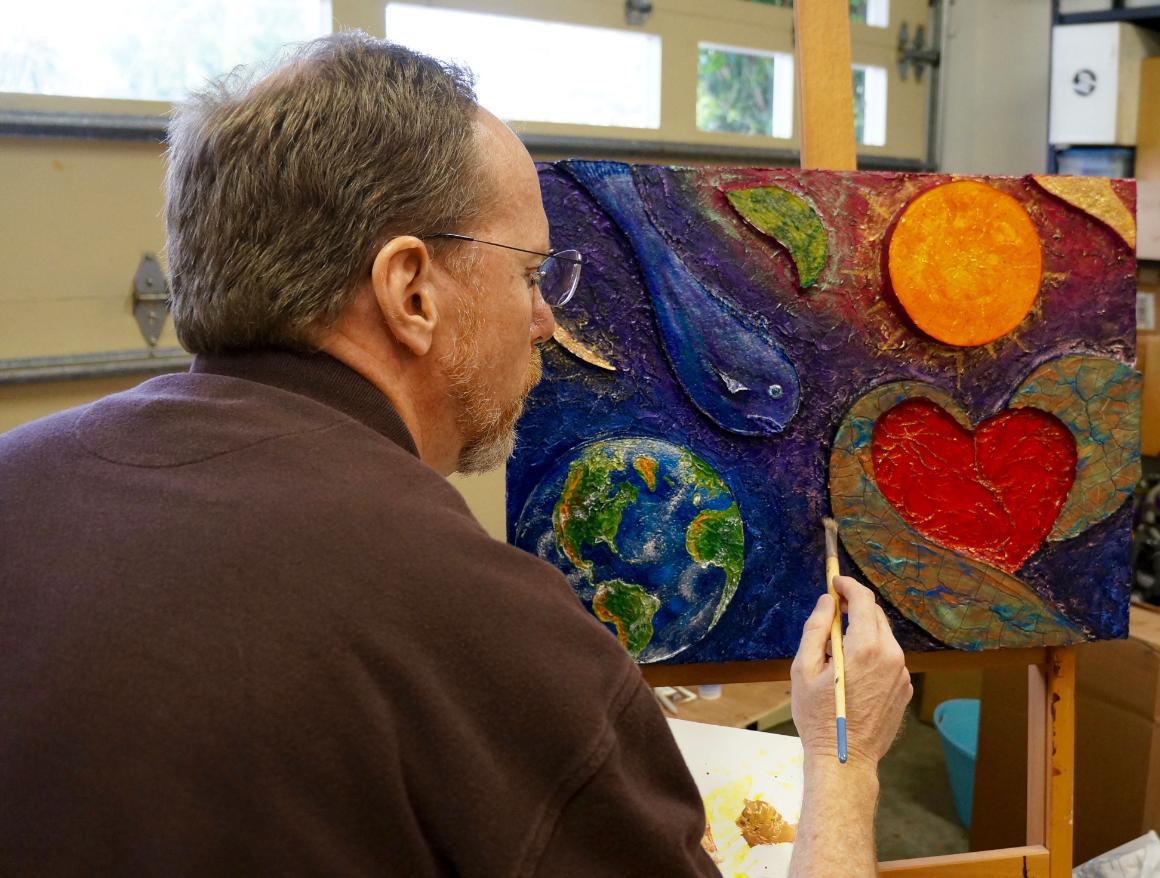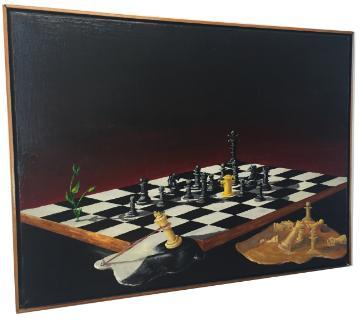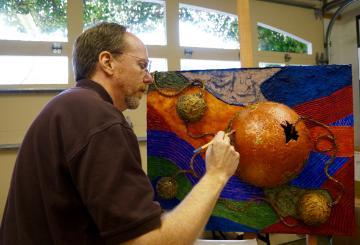
A Drive to Create
Provost Dennis Jacobs and the Spirituality of Painting
Nowadays, fewer people are attending church services, more youth identify as “nones” than ever before, and quick fixes to issues have tried to take the place of disciplined lesson learning. However, upon deeper inspection, you will find beneath these challenging trends a deep desire both for meaning and for a connection to something greater than oneself. There are people across the university--faculty, staff, and students alike--who work daily to connect the head with the heart, often with the backdrop of a well-established religious, spiritual, or philosophical practice that is in conversation with modernity. Having a spiritual practice is key in helping students develop a deeper sense of meaning, providing them with tools to weather difficult times, and helping them see the good around them.
With that in mind, I thought the pursuit of connecting to something greater than ourselves (I call it “God”) among our community members was worth highlighting, so I sent a few invitations out and had a chat with Provost Dennis Jacobs about how painting is a spiritual practice for him.
Smith: So how did you start painting?
Jacobs: I started at age 10. I took a class and began by painting landscapes. You know--paint an ocean. I really enjoyed the creativity of interacting with media. All kids color with pencils and crayons and stuff, but paint just had this new dimension to it. So that was a very informal class that my parents signed me up for. It wasn’t until I got to college that I actually started to study drawing and painting in a more formal way. In my sophomore year, I created that chess painting as an experiment in surrealism.

That came from a dream that I had, and it’s called “The Crucifixion.” You can see the Christ figure there is being constrained by a rubber band on a paper clip. The fire hydrant is Pontius Pilate, and the sort of the Satan figure is depicted in the background. These pawns along the side would be the Disciples, just kind of melting away. This sprout is the sign of the new life, or Resurrection. And so, I dreamed myself actually in this scene, and then I went and painted it, trying to capture it and trying to convey the elements of movement. This would be an example of surrealism. I’d say when I first started painting I was very much a realist. I was trying to paint things the way they look and all my early paintings, of which I have stacks in the garage--whether they’re animals or scenes of one sort or another--tried to be as realistic as possible. But at the end of the day, photorealism doesn’t allow me to express the same intensity of feeling as more abstract work does. So I moved into abstract and expressionist art in my more recent years--in the last 5 years or so. I didn’t paint very much after my college years until about 5 years ago. When I came back here to California and we had space in the garage, I set up a studio and rediscovered painting as a way to step away from my busy, professional life. It became a creative outlet that was fulfilling and relaxing at the same time.
Smith: Is it something that helps you process what you’re experiencing on a daily basis?
Jacobs: So I often will imagine a concept or picture well before I paint it. It appears in my mind … you know, like a song you can’t get out of your head. You hear it and then it’s a brain worm, and so when I picture an image, I have this longing within me to create it and to bring it to life, which is the painting process. I find myself in this period of anticipation, after I’ve visualized an image, but before I actually produce it, which almost gives me a sense of “I need to create this. I need to do it now.” It becomes a drive, and I have to carve out time to work on the painting. Then after I finish the painting, and there’s a sense of joy in the completion, I’ve fulfilled that longing until the next one comes along. So, the frequency can be somewhat sporadic. I cannot just sit down and paint; I really have to respond to that inner call--that I have a vision of something and I need to breathe it to life. And so, I’m finding my frequency increasing. For example, in the first two months of 2016, I think I did four paintings. For me that’s a fast clip. In the past, I might do one every couple of months. I don’t know what that says, but more ideas are coming forward and more drive to bring them into reality.
Smith: Maybe it means that the University is heading in a creative direction. (Chuckles from both)
Jacobs: Could be.
Smith: So all of what you’re describing, sounds like a spiritual practice. Can you put it into your own terms? How is this a spiritual practice for you, when you talk about responding to the inner call and creating something and bringing it to life?
Jacobs: Right. Some, but not all of my pieces, have a deeper meaning to them, and you can see that in this one and each of these. In contrast, this one is much more of an experiment in texture, form and color, but the other four all have some deeper symbolism. In all of these pieces, like in prayer, I don’t know necessarily where I’m going to end up when I start. You have a sense [of where you’re heading] as you move into any spiritual practice, but I think part of the joy comes from the evolution of where it leads you, where it takes you. And along the way you realize things as they begin to take flesh, take root, become substantive. That’s exciting. During a project, I’ll often deepen my passion and my commitment to the project as it evolves and unfolds, in a similar way as a spiritual practice. I think as you become more in tune or one with your creator, or a sense of deeper purpose or meaning, you become more invested, more engaged, and I feel the same way as I paint. And then, when I look back on a prior work, it brings back all those experiences and feelings I had at the time of creation and the time of uncovering that deeper meaning.
Smith: You said, too that some of these come out of dreams for you. Is there a connection there at all?
Jacobs: I don’t have a great memory or recollection of my dream states, so I don’t wake up in the morning and typically recall the dreams I had the night before. But, images, I think, do stay with me. I might see something and I’m reminded of an image and think, “Where is that image coming from?” and I connect it back, oftentimes, to a dream or collage of images that frankly I’ve never seen with my own eyes, but I’ve conjured up.

Dennis Jacobs paints a mixed media piece
Part of them I think stems from a desire to discover or express deeper meaning. Part of them I find to be very much about play, and this is a good example of play--trying to interact with various media and just seeing what happens. And as a scientist, that is actually what lab work is all about. You might have some guesses as to how nature will behave or what’s going to happen in a particular scientific experiment, but one always has to be open to new discovery and serendipity. “I don’t always know what I’m going to find, but I’m very curious. I’m going to explore and try to validate my conception of reality, and if a particular experiment doesn’t work, I’ll try something else.” That mindset of creative play, translates very readily from scientific discovery-based lab work to interacting with visual media. Many of my paintings are classified as mixed media, because I don’t stick to just one material. I have literally gone in my backyard and grabbed objects out of the yard, and incorporated them into my paintings. And there is a spontaneity to that and a sense of, “Well, let’s see what happens when I mix this with that!”
Smith: It’s neat to sit in here and be surrounded by all this work and to think about the process involved. It’s poignant to bring that drive for science together with the artistic side of it, that they’re kind of in conversation with one another.
Jacobs: Yes, I express myself in many different ways, but I am inherently one person. I believe that as we discover and engage in our life work, whether it’s in our personal lives or professional lives, in our vocation or our avocation, it’s all stemming from the same creative source. Too often, we classify the natural sciences and the arts as being opposites. I find a lot of interplay between them. I’m also a musician and I find that there’s rich discussion about how engagement in mathematics and music are highly correlated. And so, I would say, chemistry and painting both involve mixing elements to create something new. You could say they are natural siblings to one another in the larger family of academia.
Smith: And it feels very in line with Jesuit education to be having these things in conversation with one another.
Jacobs: I agree wholeheartedly. Within Jesuit education, we talk about developing the whole person to fully realize one’s talents for the greater glory of God and in service to others. In many of my paintings, I strive to convey deeper meaning or express an image that transcends the natural world. I think as we create, that is maybe one of the highest callings; to project beauty of a transcendent nature. I found that I can be much more expressive when I wasn’t constrained by photorealism. My current drive in painting is to create things that, frankly, don’t exist today in any real way, perhaps call to mind something physical, but also, I think, have some undertones of what’s transcendent and remind us of a deeper truth in our lives.
Smith: Do you find yourself in a “flow” state when you’re painting. With athletes, we talk about “flow.” Do you find that you get into that state?
Jacobs: I do, and when I’m in that state, I don’t want to leave that state, which means that if I’m on a roll, I will literally lose track of time and it could be 2 or 3 in the morning and I’ll still be painting in the garage. You have to allow for the material to dry and evolve, but apart from that, I’m a fairly impatient painter, meaning I just want to move to the next step, the next phase. And so, the material sometimes requires you to step away, but my impulse is not; my impulse is just to stay in the groove.
Provost Dennis Jacobs paints in his studio